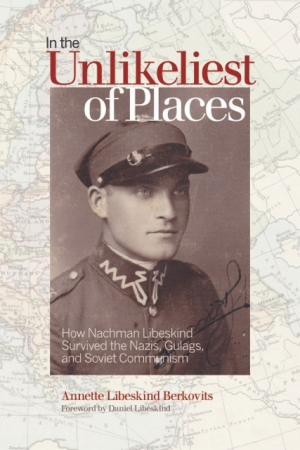In the Unlikeliest of Places
How Nachman Libeskind Survived the Nazis, Gulags, and Soviet Communism
This survivor’s story is less about enduring than it is about living vibrantly.
Annette Libeskind Berkovits’s The Unlikeliest of Places is an incandescent biographical tribute to the author’s father, Nachman Libeskind, an eternally hopeful survivor.
Nachman’s boyhood in Poland was dominated by Bundism, Jewish tradition, and his burgeoning love for art. He loved the land of his birth and reveled in Yiddish culture, allegiances he maintained even through the horrors of Nazism. Fleeing persecution, Nachman ended up in a Russian gulag, where he endured terrible conditions with what spirit he could summon.
From the gulag, Nachman moved to Kyrgyzstan with his young wife, Dora; they bettered their growing family’s situation via hard work and hope, with Nachman maintaining a philosophy that his family’s glass would always be “filled with milk and honey.” A return to Poland could not yield the joyous family reunions they’d hoped for, and they pushed toward new land, emigrating first to Israel and then to America.
Berkovits relates her father’s story in elegant and shifting prose. Sections devoted to Nachman’s backstory read like a novel, but between them come peeks at the author’s life with her father. Her travels with Nachman, and her struggles to understand his quirks, are all imparted with affection.
Nachman insists, again and again, on returning to Poland to honor the dead; Berkovits herself is frank about her lack of enthusiasm for the nation, where anti-Semitism is shown to be still very much alive. Yet she goes with love. And she encourages her father, with love, to pursue the dreams he had been forced to sideline, from taking up painting and multimedia art in his seventies to recording his life’s story on tapes that she later transcribed. This dance between a father’s story and a daughter’s quest for insights and understanding is moving and lovely, and makes moving forward in the book, even with its jumps in time, a continual reward.
The book addresses the complications of maintaining one’s Judaism after the Holocaust with skill. In Israel, Nachman struggles against the tendency to discard aspects of European Jewish life, holding on to his Yiddish as though it is a jewel; in America, he struggles equally with the expectations of religious Jews, whose faith he cannot comprehend, especially after the Shoah. Berkovits traces such challenges through her generation and the next, and this journey—a story within the story—warrants attention and reflection.
Some of Nachman’s art is included late in the book, adding dimensionality to a text already replete with it. Those not already familiar with the Libeskinds by virtue of Nachman’s artistic catalog or because of the work of his son, Daniel, the famed architect, will find much here to celebrate. Though this is, inescapably, a Holocaust survivor’s biography, it is not dominated by those horrors; rather, it celebrates the ingenuity with which one man made his time less about enduring than about living vibrantly.
In the Unlikeliest of Places honors the life of an artist, a father, and a survivor who maintained his sense of identity with gentility, despite the historical challenges he endured.
Reviewed by
Michelle Anne Schingler
Disclosure: This article is not an endorsement, but a review. The publisher of this book provided free copies of the book and paid a small fee to have their book reviewed by a professional reviewer. Foreword Reviews and Clarion Reviews make no guarantee that the publisher will receive a positive review. Foreword Magazine, Inc. is disclosing this in accordance with the Federal Trade Commission’s 16 CFR, Part 255.

